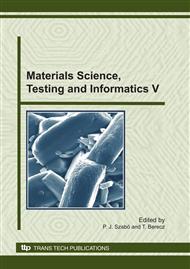p.331
p.337
p.343
p.349
p.355
p.361
p.367
p.373
p.379
Nondestructive Inspection of Ductile Cast Iron by Measurement of Minor Magnetic Hysteresis Loops
Abstract:
Systematic measurement of minor magnetic hysteresis loops of traditional hysteresis tests requires substantially lower magnetization of samples and offers higher sensitivity of detection of changes in the ferromagnetic materials’ microstructure. The keynote idea of this method, called Magnetic Adaptive Testing (MAT) is utilization of sensitive correlations between the varied microstructure of the magnetized material and the corresponding, highly sensitive modifications of some of the minor hysteresis loops. The paper presents some of the recent results of the MAT measurement performed on specially prepared series of cast iron samples. Results of the non-destructive magnetic tests were compared with the destructive mechanical measurements of Brinell hardness and linear correlation was found between them. A very good correlation was also found between magnetic descriptors and conductivity and chill/ferrite area fraction. Based on these results, Magnetic Adaptive Testing is suggested as a highly promising non-destructive method for monitoring structural changes in different types of ferromagnetic materials.
Info:
Periodical:
Pages:
355-360
Citation:
Online since:
September 2010
Authors:
Keywords:
Price:
Сopyright:
© 2010 Trans Tech Publications Ltd. All Rights Reserved
Share:
Citation:


